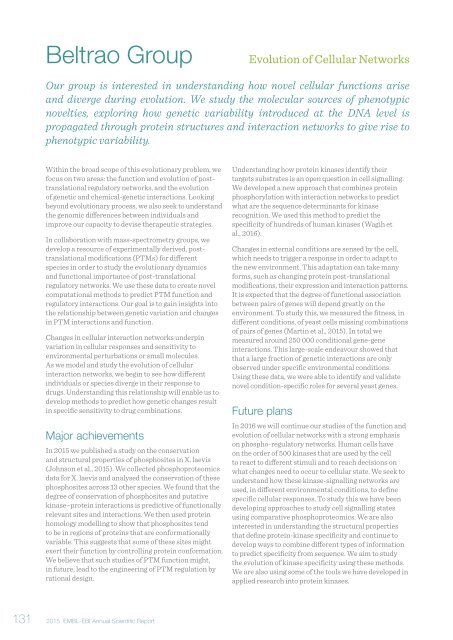Annual Scientific Report 2015
EMBL_EBI_ASR_2015_DigitalEdition
EMBL_EBI_ASR_2015_DigitalEdition
Create successful ePaper yourself
Turn your PDF publications into a flip-book with our unique Google optimized e-Paper software.
Beltrao Group<br />
Evolution of Cellular Networks<br />
Our group is interested in understanding how novel cellular functions arise<br />
and diverge during evolution. We study the molecular sources of phenotypic<br />
novelties, exploring how genetic variability introduced at the DNA level is<br />
propagated through protein structures and interaction networks to give rise to<br />
phenotypic variability.<br />
Within the broad scope of this evolutionary problem, we<br />
focus on two areas: the function and evolution of posttranslational<br />
regulatory networks, and the evolution<br />
of genetic and chemical-genetic interactions. Looking<br />
beyond evolutionary process, we also seek to understand<br />
the genomic differences between individuals and<br />
improve our capacity to devise therapeutic strategies.<br />
In collaboration with mass-spectrometry groups, we<br />
develop a resource of experimentally derived, posttranslational<br />
modifications (PTMs) for different<br />
species in order to study the evolutionary dynamics<br />
and functional importance of post-translational<br />
regulatory networks. We use these data to create novel<br />
computational methods to predict PTM function and<br />
regulatory interactions. Our goal is to gain insights into<br />
the relationship between genetic variation and changes<br />
in PTM interactions and function.<br />
Changes in cellular interaction networks underpin<br />
variation in cellular responses and sensitivity to<br />
environmental perturbations or small molecules.<br />
As we model and study the evolution of cellular<br />
interaction networks, we begin to see how different<br />
individuals or species diverge in their response to<br />
drugs. Understanding this relationship will enable us to<br />
develop methods to predict how genetic changes result<br />
in specific sensitivity to drug combinations.<br />
Major achievements<br />
In <strong>2015</strong> we published a study on the conservation<br />
and structural properties of phosphosites in X. laevis<br />
(Johnson et al., <strong>2015</strong>). We collected phosphoproteomics<br />
data for X. laevis and analysed the conservation of these<br />
phosphosites across 13 other species. We found that the<br />
degree of conservation of phosphosites and putative<br />
kinase–protein interactions is predictive of functionally<br />
relevant sites and interactions. We then used protein<br />
homology modelling to show that phosphosites tend<br />
to be in regions of proteins that are conformationally<br />
variable. This suggests that some of these sites might<br />
exert their function by controlling protein conformation.<br />
We believe that such studies of PTM function might,<br />
in future, lead to the engineering of PTM regulation by<br />
rational design.<br />
Understanding how protein kinases identify their<br />
targets substrates is an open question in cell signalling.<br />
We developed a new approach that combines protein<br />
phosphorylation with interaction networks to predict<br />
what are the sequence determinants for kinase<br />
recognition. We used this method to predict the<br />
specificity of hundreds of human kinases (Wagih et<br />
al., 2016).<br />
Changes in external conditions are sensed by the cell,<br />
which needs to trigger a response in order to adapt to<br />
the new environment. This adaptation can take many<br />
forms, such as changing protein post-translational<br />
modifications, their expression and interaction patterns.<br />
It is expected that the degree of functional association<br />
between pairs of genes will depend greatly on the<br />
environment. To study this, we measured the fitness, in<br />
different conditions, of yeast cells missing combinations<br />
of pairs of genes (Martin et al., <strong>2015</strong>). In total we<br />
measured around 250 000 conditional gene-gene<br />
interactions. This large-scale endeavour showed that<br />
that a large fraction of genetic interactions are only<br />
observed under specific environmental conditions.<br />
Using these data, we were able to identify and validate<br />
novel condition-specific roles for several yeast genes.<br />
Future plans<br />
In 2016 we will continue our studies of the function and<br />
evolution of cellular networks with a strong emphasis<br />
on phospho-regulatory networks. Human cells have<br />
on the order of 500 kinases that are used by the cell<br />
to react to different stimuli and to reach decisions on<br />
what changes need to occur to cellular state. We seek to<br />
understand how these kinase-signalling networks are<br />
used, in different environmental conditions, to define<br />
specific cellular responses. To study this we have been<br />
developing approaches to study cell signalling states<br />
using comparative phosphoproteomics. We are also<br />
interested in understanding the structural properties<br />
that define protein-kinase specificity and continue to<br />
develop ways to combine different types of information<br />
to predict specificity from sequence. We aim to study<br />
the evolution of kinase specificity using these methods.<br />
We are also using some of the tools we have developed in<br />
applied research into protein kinases.<br />
131<br />
<strong>2015</strong> EMBL-EBI <strong>Annual</strong> <strong>Scientific</strong> <strong>Report</strong>


